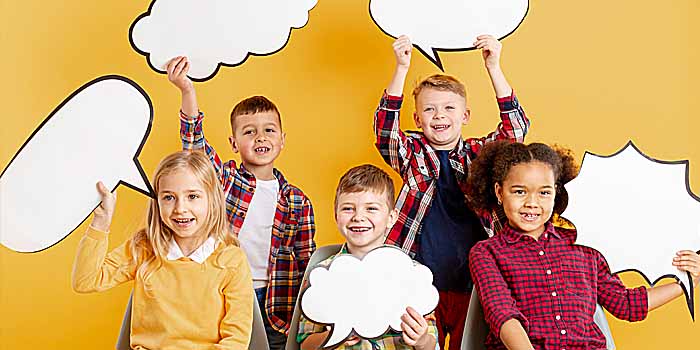A newborn makes loud screams in the form of vowels such as a, e, i, u. With the development and formation of the digestive organs, it gradually begins to produce consonant-like sounds. When the newborn is hungry, it swallows with its mouth and creates labile consonants such as p, b, m, and when swallowing food, throat consonants are formed such as g, h, k, and then, gradually, other sounds develop. By the end of the 1st year, the child uses vocals more often than consonants, and in the 2nd year, this relationship changes in favor of consonants. In the 1st month of life, 90% of the consonants produced by the newborn are glottal consonants, and by the end of the 1st year, they are reduced to 30% because other consonants appear such as p, b, m, v, t, f, d, n. In the 3rd month, the newborn goes from screaming to humming. It entertains itself by letting out various sounds, connecting them with each other in different ways and thus it begins to form the first syllables. The order in which these sounds appear in the child is the result of the functional maturation of the nervous system and musculature.
| Age | Speech Development |
|---|---|
| Birth to 5 Months | • Makes sounds: laugh, giggle, coo, cry, squeal. • With voices noticeably expresses satisfaction and dissatisfaction. • The tone of crying is different for different needs. |
| From 6 to 11 Months | • Babbles. • Vocalize syllables: ma-ma, ba-ba, da-da. • Makes gurgling sounds during playing alone or with other. • Changes tone of voice. • Makes various sounds accompanied by mimics and gestures in try to communicate. • Pronounces the first words that make sense. |
| From 12 to 17 Months | • Imitates speech sounds. • Answers simple questions with mimics and gestures. • Unclear pronunciation of a couple of words to point a person or object. • Imitates simple words. • Say a few words, such as dada, mama. • Recognize words for common items. • Understand simple instructions and phrases. • Follows one-step commands when shown by a gesture. • Says more words as each month pass. • In this period has a vocabulary of around 4 to 6 words. |
| From 18 to 23 Months | • Imitates animal sounds. • Able to pronounce 2-word phrases. • Answers with yes and no. • Labels common foods by name. • Combines everyday common words. • Understands the meaning and uses the word mine. • Understands the concept of size and uses the words big, little. • In this period has a vocabulary of around 10 to 50 words. • Pronunciation of words is still unclear. |
| From 2 to 3 Years | • Uses simple spatial-concept such as: in, on. • Uses pronouns, such as you, me, her. • Understands and uses simple descriptive words, such as cold, hot, big, small. • Improves speech accuracy according to age. • Answers very simple questions with two to three words. • Uses more pronouns, such as I, you, her. • Uses question inflection to ask for something, such as “My toy?“. • Uses plural words such as toys, shoes, cubes. • Uses simple 3 to 4-word sentences. • Asks simple 1 to 2-words questions. • In this period has a vocabulary of 50 to 60 words. • At least half of his speech is understood by others. • Uses 100 or more words by the end of 2nd year of age. • Pronunciation is improving with some surplus ending sounds. |
| From 3 to 4 Years | • Recognizes and tells basic colors. • There are still difficulties with pronunciation of r, s, sh, ch, y, v, z, th, sounds, but most of the other sounds are clear. • Uses more consonants in words, some more, some less successfully. • Other then parents understand much what the child saying. • Understands and describes the use of objects such as bed, spoon, bicycle, car, house. • Recognizes absurdities in language. • Ends verbs with ing. • Answers the questions with obvious answers. • Answers why questions. • Understands complex questions, but answers with simple sentences. Past tense verbs in some cases are still irregular. • Difficulties in pronouncing complex words. • Uses about 400 plus words by age of 3 years. |
| From 5 Years Onward | • Engages in conversation. • Sentences are longer than 9 plus words in length. • Compound and complex sentences are more common in his verbal expression. • Describes the objects in more detail. • Begins to imagines and tells stories. • Understand and describes the sequence of events. |
First, the child begins to utter a syllable, connecting the consonant m that is formed with the lips (the part of the body muscle that the newborn uses the most), with the simplest vowel a, and thus creates the syllable ma. Later, the child will start repeating the same syllable over and over again, such as ma-ma, da-da, no-no, ba-ba, and the like. At the end of the 1st year of life, usually at 11 months, the first complete words like mama, dada will appear in its speech. From the age of 9 months onward, the child already understands certain parts of the speech it hears and begins to imitate them. In this way, it practices and the voices and syllables it spontaneously produces form various, new, mutually-logical, articulated combinations. Thus, during the transition to the 2nd year of life, the child begins to develop true speech.
There is some contrast between speech development and motor skills. At the end of the 1st year, when the child starts saying the first words, the development of motor skills slows down, and when the child starts to walk, there is a delay in its speech. In the middle of the 2nd year, when the child has fully mastered the skill of walking, the number of words it uses begins to increase rapidly. Until it is able to say all the words according to the current degree of its intellectual maturity, the child uses gestures as a substitute for communication.
About 18 months of age, the child with the help of speech accurately points to other people and objects around it and accurately expresses its feelings, desires, and needs.
A child’s speech already have a signifying function. Then it starts asking for names of objects, phenomena, and people, and its vocabulary mostly contains nouns and exclamations, and later on, simple verbs.
Rubinstein S. L.
The child becomes more precise in pronunciation, listening, and imitating the speech of others, so that its speech becomes more and more understandable.
During the 2nd year, the number of words in the child is enriched.
• At the age of 12 months, the child uses 3 words.
• At the age of 15 months, the child uses 19 words.
• At the age of 18 months, the child uses 23 words.
• At the age of 22 months, the child uses 118 words.
• At the end of the 2nd year, the child uses 272 words.In that period, the child can connect 2 to 3 words in a simple sentence, unlike before when it tried to express itself with only one word.
Smith M. E.
Thus, its speech initially consist of a rough, unfinished vocalization by which the child responds to stimuli. Gradually it turns into a growing number of different sounds. Listening to and imitating the speech of the people around it, the child begins to compose different combinations of words, which in the end gives them meaning and it verbally expresses its thoughts.
In the development of speech, we meet again with the principle of individualization and integration, which is characteristic of the overall psychological development. In the beginning, the child’s speech are spontaneous and difficult to understand, and later it becomes clearer and more precise, and that is the result of the repetition of words and sentences heard in the speech of the people around it.
In preschool, speech continue to improve. By the age of 5, the average child already has a vocabulary of 2,000 words. In addition to nouns and verbs, it uses other types of words. The child begins to change words in terms of declension and conjugation so that its vocabulary is more complete, richer, and more diverse. During that time, the intelligibility of its speech significantly improves.
• At the age of 2, 32% correctness in articulation
McCarthy D.
• At the age of 3, 63% correctness in articulation
• At the age of 4, 77% correctness in articulation
• At the age of 5, 88% correctness in articulation
A child’s speech increase significantly in preschool age.
• At the age of 2, 78 words per hour
Smith M. E.
• At the age of 4, 400 words per hour
At preschool age, the child begins to use complete sentences of 6 to 8 words and less incomplete sentences that were characteristic of the previous stages. Sentences become longer, and in addition to the main sentences it begins to use conditional sentences, and in addition to nouns, pronouns, and verbs, the sentences now contain adjectives, numbers, and prepositions. At the age of 4, the child starts using speech in the future tense and a little bit later it will start using the past tense as well. At the same time, the number of pronouns in the child’s speech decreases, which is a sure sign of maturation.
A small child while talking connects the content of the speech with the current situation and place where it is while talking to its interlocutor. This is the so-called “situational speech”. The interlocutor can understand the child’s speaking only if he is present in its immediate vicinity and sees what the child is talking about. The child often omits the object, replaces the nouns with pronouns, it is easier for it to use adjectives, and for adjectives, it uses like this, gestures, changes the tone of speech, and abundantly uses facial expressions to express what it still doesn’t know how to say in words. Around the age of 4, the child increasingly uses intelligible so-called “contextual speech”, and is intelligible in itself, regardless of the current situation, talking about people, objects, or events that are not present or do not happen at the moment when talking about them, and it increasingly uses thought concepts in speech. In this way, children’s speech acquires meaning and is an increasingly appropriate means of social communication, mutual understanding, but also recognition of the world through the improvement of language.
Speech in a child significantly contribute to the progress of thinking, because through thought, the verbal expression is formed, the thought becomes meaningful and concrete.
Speech not only expresses a thought but also contributes to its formation.
Rubinstein S. L.
A preschooler constantly asks questions that mainly concern the cause-and-effect relationships between things and social relationships between people. The child often asks questions about things he already knows the answer to, this serves as self-affirmation of what he already knows and as approval from the environment for such a way of thinking and expressing. With each successive answer to the same question, the child consolidates its knowledge.
In preschool, the child sometimes talks only with itself – “monologue”. Arbitrarily adds syllables to different words. In this way, it composes its own coinages of words from several terms depending on how it experiences the action and its affective relationship.
The monologue is egocentric speech that serves for better understanding and more rational planning of action.
Piaget J.
With a monologue, the child addresses a fictional listener or interlocutor and thus announces its intention to act, what it thinks, wants, or plans to do.
Vygotsky L. S.
The child uses various unusual words, composed of 2 syllables. It is an “Autonomous speech”, with which the child generalizes the idea of things.
Vygotsky L. S.
Just before the end of preschool age, children’s speech are significantly socialized, that is, it becomes a means of communication and dialogue.
Piaget J.
If adults often address and talk to the child, it rarely uses monologue. In such a case only 4% to 5% of its speech is reduced to egocentric speech.
Mc Carthy D.
Piaget J. finds that monologue accounts for as much as 40% of speech in preschool children raised in orphanages. Based on this data, Piaget J. argues that children’s speech from the beginning is always egocentric, that is when the child performs an activity without people from the environment intervening or participating in the same activity.
Most psychologists do not share this view of Piaget J. In general, the prevailing belief is that speech from the beginning is a social skill that gradually develops under the influence of the environment and always moves in that direction.
Basic speech development generally end in the 5th year. By then, the child’s speech and language are already understandable, full of words and it’s grammatically correct and can serve as a skill for communication, expression of thought, and acquisition of knowledge. With the development of the child, its vocabulary is enriched, the grammar is improved, and the sentences become longer and more complex. Education contributes a lot to the enrichment of speech. One of its basic tasks is to prepare the child for the most skillful and as complete as possible differentiated speech expression.
Large individual differences among children are observed in speech development. Intellectually gifted children usually acquire all the components of speech faster than less gifted children. Relatively fast speech maturation is always a sign of above-average intelligence. But a child’s lag in speech shaping is not evidence that his or her intelligence is below average. There are above average intelligent children who start speaking at the age of 2 – 2 and a half, or even 3 years. But children with mental health problems always start talking later, usually at the age of 4 years. If the child significantly lags behind its peers in speech, it raises suspicion of impaired functions that condition the proper development of speech. Most often it is deafness or insufficient mental development.
Speech develop faster in girls than in boys. Girls reach full maturity of the articulation on average one year before boys.
- Start forming sentences earlier.
- Vocabulary is richer than the vocabulary of boys of the same age.
- Speech become understandable earlier.
- Pronounce consonants better than boys and speak more.
- They learn to read more easily, learn languages, and achieve better school results in subjects that require agile expression.
Speech, reading, and writing disorders are twice as common in boys as in girls.




